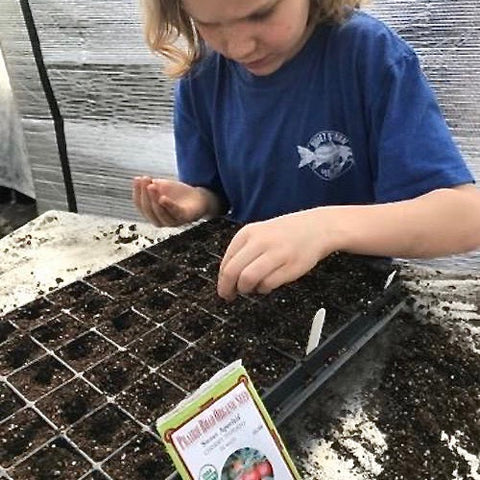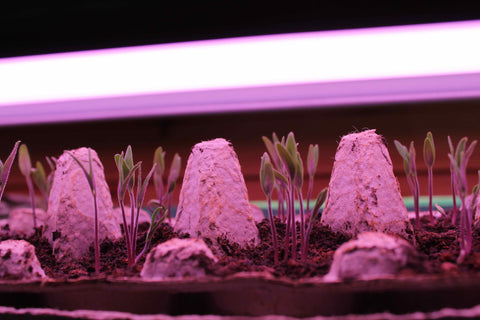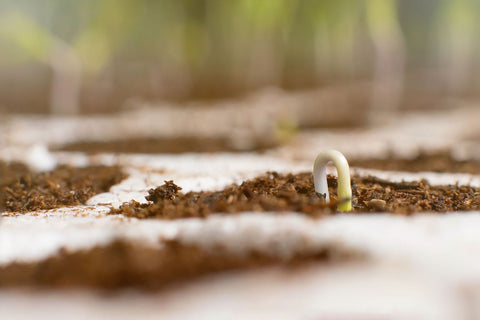
Debunking Twelve Seed Starting Myths and Making It Right
Share
Starting seeds is an exciting and rewarding way to kickstart your garden. And it opens up a whole new world of varieties that are not available at your local garden center. Maybe you wanna try a heirloom variety or a new variety you've never grow before. If you’re looking for something different, you’ll likely have to start it from seed. And it saves you money!
However, there are several myths and so called 'seed starting hacks' floating around that can lead to confusion and frustration. Let's debunk 12 common seed starting myths to help you successfully germinate and grow healthy seedlings.
Myth 1: Soaking seeds overnight improves germination
It's a popular belief that soaking seeds overnight can speed up germination. While this may work for some seeds, it's not necessary for most. In fact, soaking certain seeds can actually harm them. I get calls every year from gardeners who literally soaked and killed their seed. Follow the instructions on the seed packet for optimal germination; only soak your seeds if directed to do so.
Myth 2: Planting seeds deeper ensures better growth
Planting seeds too deep can hinder germination. Some seeds actually require light to germinate and need to be surface sown. Other seeds are so small that planting them too deep will mean the seedlings won't have the where-with-all to push the soil up and make it outta the ground! The general rule of thumb is to plant seeds at a depth equal to two to three times their diameter. The smaller the seed, the more shallow the planting. Be sure to check the specific planting depth instructions for each type of seed your planting.
Myth 3: Seeds need constant warmth to germinate
The right germination temperature is important however, some seeds require cooler soils and some warmer. Once the seeds have germinated, some can be exposed to a slightly cooler location to promote healthy growth, while others, such as peppers, are heat lovers and come to a stand-still if chilled. Pay attention to warm season plants and cool season plants and provide them with their optimum growing environments.

Myth 4: Seeds need bottom heat to germinate
While bottom heat from heating pads can be beneficial for certain seeds, not all seeds benefit from or require it. Some seeds, like lettuce and onions, are cool season plants and prefer cooler temperatures for germination. Using a heat mat with these seeds will actually prevent, rather than speed germination. I have had more than one customer get zero germination from their onion seed while the trays were on a heat mat. As soon as they removed the heat, the onions came up without having to replant. So the seeds were actually in a 'holding pattern' waiting for cooler temps to germ! Again, refer to your seed packet and do your research.
Myth 5: When germinating seeds, it's best to water or mist frequently
Getting the water right is important! When planting your seed trays start with slightly moist but workable soil. If your soil is too dry, the water will bead on the surface instead of soaking in. That can cause your seeds to float and clump together. If your soil is too wet, it'll be sticky, making planting difficult. Moisten your starter mix a little at a time to get it right. Fill your trays with moist but not wet soil. Plant your seeds. Using a spray bottle set to a very light mist, wet the surface slowly, making sure not to dislodge the seeds. With the surface wet water will soak in readily. Water slowly until the cell is well watered but not soggy or saturated to the point of pooling. Cover the tray with plastic or a dome to prevent it from drying out while you wait for seedlings to emerge.
The goal of covering the trays is preventing the need to re-water the them again before germination. We like to use sheets of indoor window plastic to cover the trays--the kind of window film you use a blower dryer to shrink to size. We lay it over the top and tuck the edges in under the trays to prevent moisture from escaping. Another option is to place the trays in clear bread bags that can be tucked or sealed on the open end.
Each type of seed has its own germination schedule, which can vary widely. Some seeds may sprout within a few days, while others may take weeks. Place a piece of tape with the expected date of emergence written on it next to each type of seed you plant. This will help you when keeping watch for emergence. Patience is key when it comes to seed starting. Understand the expected germination window for each seed type.
Myth 6: You should put your freshly planted seed trays directly under grow lights
While some seeds require light to germinate, most do not; again pay close attention to those planting depths and light requirements. We start most of our seeds on our dining room table, which is not near a window. Those seeds that require light to germinate will germ well in a sunny window. If you don't have a window with good light exposure for seeds that do need light to germ, put them under grow lights for 12-16 hours a day. Give them at least 8 hours of darkness to mimic the natural light rhythm of day and night.

Getting seedlings under grow lights to ensure adequate light for proper growth.
Even seeds that require soil cover and darkness to germinate, will require grow lights immediately after they emerge from the darkness of the soil. If they don't get enough light at this crucial stage, they'll start elongating and reaching for light. So watch carefully for emergence and get them under the lights ASAP. If you can set the lights on a timer for 12-16 hours on and at least 8 hours off- or make it a point to turn them on at the same time in the morning and at night. Try to mimic the lengthening of daylight in your region to sync your plants to the rhythm of the sun. Again, pay attention to the light requirements for germination and the 'Days to germination' information on your seed packet and be on the lookout for germination.
Myth 7: You need to fertilize seeds at planting time
Seeds contain all the nutrients they need to germinate and develop their first set of leaves. They are a self-contained complete package. Fertilizing at planting can actually 'burn' the delicate emerging seedlings causing them to turn yellow and then brown-- this is actually called 'fertilizer burn'.
Myth 8: Transplanting seedlings early promotes stronger growth
On the contrary-- transplanting seedlings too early can cause stress and shock, leading to stunted growth. When seedlings emerge their first 'leaves' are actually the cotyledon leaves-- the seed leaves held within the embryo of a seed. Before transplanting into a nutrient rich soil, let the seedlings develop a strong enough root system and at a least one set of 'true leaves'. This will better equip them to deal with being disturbed and transplanted.
Myth 9: Seedlings need direct sunlight from the start
While sunlight is essential for seedling growth, if the seedlings started life inside under grow lights, exposing them to direct sunlight could scorch their delicate leaves. Gradually introduce seedlings to sunlight by placing them in a partially shaded area and gradually increasing their exposure over a number of days until they can take the full sun.
Myth 10: Watering seeds multiple times a day is necessary
Overwatering can lead to root rot and damping-off disease. Most seeds only require consistent moisture, not constant saturation. Water your seeds when the top of soil feels dry to the touch. Bottom watering is preferable. Stick to room temperature water for watering your seeds. Understand the specific moisture requirements for the seeds you're working with.

Myth 11: All seeds can be started indoors
As we discussed last week, while many seeds can be started indoors, some are best sown directly in the garden. Certain plants, like root vegetables and large-seeded plants, don't transplant well and should be directly sown into the soil.
Myth 12: Seed starting is a complicated process
Starting seeds can seem intimidating, but it doesn't have to be complicated. With a little knowledge and attention to detail, anyone can successfully start seeds and grow healthy seedlings. Don't be afraid to experiment and learn from your experiences.
I hope this list of seed starting myths helps you navigate the process of seed starting with confidence. Remember, always refer to the specific instructions for the seeds you're working with. If you haven't done so already, sign-up and download our Green Thumb Playbook and our cheat sheets for starting and direct seeding seeds. Information about days to germination, germination temperatures, planting depths-- you'll find it all on those cheat sheets!
Happy gardening!
Your gardening coach,
Theresa
